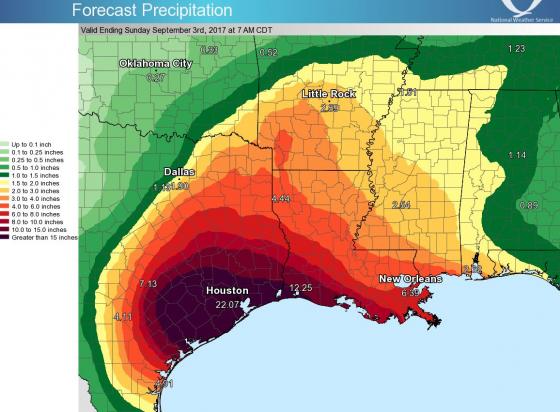Some observers have estimated that Hurricane Harvey has dropped more than 11 trillion gallons of water in Texas, triggering flooding of a dimension never seen before in the Lone Star state.
As the storm continues, an equal or higher amount of rain might be yet to fall.
According to Ryan Maue, a meteorologist at WeatherBell, a private forecasting firm, there is still up to 16 trillion gallons more rain likely to fall in the state, based on forecasts from the National Weather Service (NWS).”
Before Harvey finally leaves the state, forecasters predict up to 50 inches will fall in total, making this the greatest rainfall total ever in U.S. history from a hurricane or tropical storm.
With more rain underway and rivers still rising, first responders are heroically trying to save those trapped in flooded areas, and drones are capturing incredible footage of their rescues.
The federal government and the state of Texas are marshaling as many resources as possible to cope with the disaster, which will leave many thousands homeless and in need of shelter for many months. Neighboring states are responding, and donations are flowing into such charities as The Salvation Army and Red Cross.
The director of the Federal Emergency Management Agency, Brock Long, predicted that the aftermath of the storm would require FEMA’s involvement for years. “This disaster’s going to be a landmark event,” Long said.”
The rainfall also is causing heavy flooding in south central and southwest Louisiana.
A tropical cyclone’s rainfall potential is a function of its forward speed, not its intensity. Therefore, several more days of torrential rain are expected in many of the already flood-ravaged areas.”
Meanwhile, the dramatic footage continues across television screens, computers and mobile devices, giving users an unprecedented look at the shocking devastation that’s engulfed much of the Texas Gulf Coast and left much of Houston totally under water.
Source: ZeroHedge
Image: ZeroHeadge

